Living Stones
Lithops, often called “living stones,” are fascinating and unique succulents that mimic the appearance of stones or pebbles as a form of camouflage. Native to the arid regions of southern Africa, these plants have evolved to survive in some of the harshest environments, making them an intriguing subject for succulent enthusiasts around the world.
Lithops are small, ground-hugging plants that consist of one or more pairs of bulbous, almost fused leaves, which are often split by a fissure at the top from where the flower emerges. The leaf color and pattern vary widely among species and can resemble the surrounding rocks, helping the plant to avoid predation.
Native: They are native to southern Africa, particularly thriving in countries like South Africa, Namibia, and Botswana. Their habitats are extremely dry, rocky areas with high temperatures, little rainfall, and open skies. Living Stones belong to the fig-marigold family (Aizoaceae) along with Delosperma (Ice Plant) and Lampranthus. There are about 37 species and many varieties of Lithops.
Lithops display an enchanting array of earthy hues, including shades of tan, olive, orange, and occasionally blues, blending seamlessly with their natural stone-like environment. Each individual boasts unique markings, from intricate networks of veins to speckles and mosaics, that enhance their camouflage. Some feature pronounced fissures or ridges, adding to their geological mimicry. These adaptations, from the broad, transparent areas known as “windows” to the sparse or dense distribution of patterns, are not just for aesthetics but are vital for their survival, aiding in light filtration and moisture conservation. The diversity within their appearance ensures that no two Lithops are exactly alike, offering a mesmerizing variety to enthusiasts.
Plant Type and Habit: Lithops are small, nearly stemless succulents characterized by their compact size and slow-growing nature. Each plant typically consists of one or more leaf pairs, with new leaf pairs emerging from the fissure between old leaves.
Size: Most Lithops are very small, rarely growing more than an inch above the soil surface. Their size and spread are limited, usually not exceeding 1 to 2 inches in diameter.
Flowers: Lithops produce daisy-like flowers that can be white, yellow, or orange, depending on the species. The flowers are large in comparison to the plant body and usually bloom in the late fall or early winter. After flowering, Lithops produce small fruit capsules that contain tiny seeds. These capsules open when wet, allowing the seeds to be dispersed by rain.
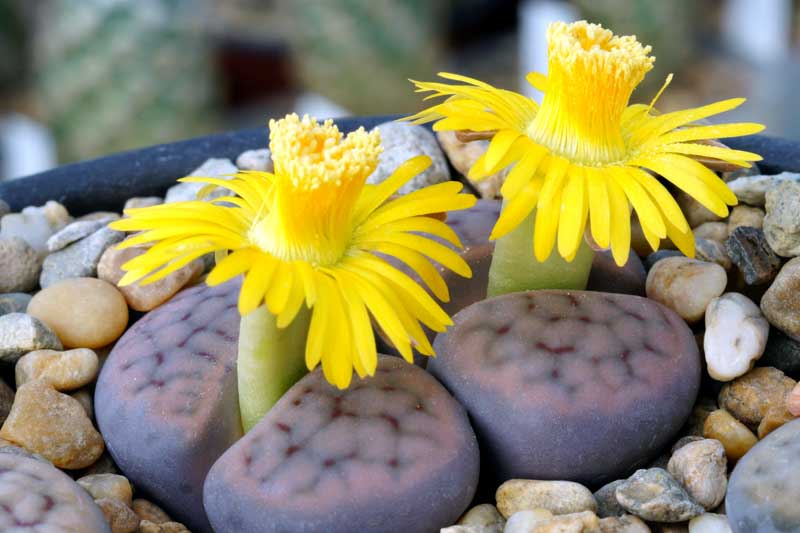
Following its flowering phase, the plant enters dormancy. As spring arrives, the plant begins absorbing its old leaves to nourish the emerging ones. The fresh growth emerges through the gap between the previous year’s leaves, orienting its split approximately 90 degrees from the preceding one for optimal light absorption and growth efficiency. In time, the old leaves dry out and form a thin, papery husk adjacent to the new growth, marking the plant’s natural renewal cycle. Additionally, many Lithops begin to split during this period, forming new pairs of leaves and gradually expanding into a tight cluster. This division allows the plant to slowly but steadily increase its presence.
Foliage: Lithops’s foliage is the most striking feature, with various textures, patterns, and colors designed to mimic the appearance of stones. The leaves are mostly water-storing organs adapted to survive long periods of drought.
Hardiness: Lithops are hardy in USDA zones 10 to 11. In cooler climates, they are commonly grown indoors or in greenhouses to protect them from frost.
Uses: Lithops are primarily grown as ornamental plants, popular among succulent collectors and enthusiasts for their unusual appearance and minimalistic beauty. They are ideal for rock gardens, containers, and terrariums.
Toxicity: Lithops are not known to be toxic to humans, pets, or wildlife. However, they are not edible and should not be ingested.
Drought: Lithops are extremely drought-tolerant, capable of surviving months without water. Their leaves store moisture, allowing them to endure prolonged dry spells.
Lifespan: Lithops can live up to 40-50 years.
Invasiveness: Lithops are not invasive. Their slow growth rate and specific growing requirements limit their spread and make them unlikely to escape cultivation.
Benefits: The primary benefit of growing Lithops is aesthetic, adding a unique and intriguing element to gardens and indoor plant collections. They also serve as a model for studying water conservation and survival strategies in plants.
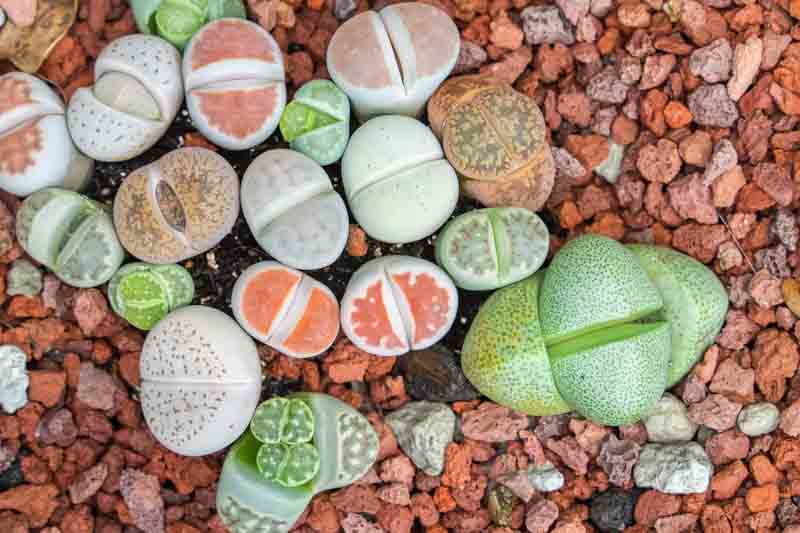
Growing and caring for Lithops can be both fascinating and rewarding.
Light Requirements: Lithops thrive in bright, indirect sunlight. Place them near a south-facing window where they can receive plenty of light without exposure to the harsh midday sun (4-5 hours of early sunlight and partial shade in the afternoon). Too little light can cause them to elongate, losing their compact stone-like appearance.
Soil: Use a well-draining succulent or cactus soil mix. Adding sand or fine gravel can improve drainage and mimic their natural gritty habitat.
Watering: The key to Lithops care is minimal watering. These plants store water in their leaves and can survive long periods without moisture. Water only when the soil is completely dry, and the leaves show signs of shriveling. Reduce watering during their dormant periods to once a month or less. During the growing season (late spring – early summer and late summer-early fall), water every 2-3 weeks, depending on the humidity and temperature.
Temperature and Humidity: Lithops prefer temperatures between 65°F to 80°F (18°C to 27°C) during the day and cooler temperatures at night. They can tolerate higher temperatures if provided with adequate ventilation. These plants do well in low to moderate humidity environments. Avoid placing them in excessively humid areas, such as bathrooms.
Fertilizing: Lithops require minimal fertilization. If necessary, apply a diluted, low-nitrogen succulent fertilizer once at the beginning of the growing season.
Repotting: Lithops have a deep taproot and require a pot that is deeper than it is wide. Repotting is rarely needed and should be done carefully to avoid damaging the roots. Lithops can stay up to 20 years in the same pot. Repot only when the plant outgrows its container, preferably during the growing season.
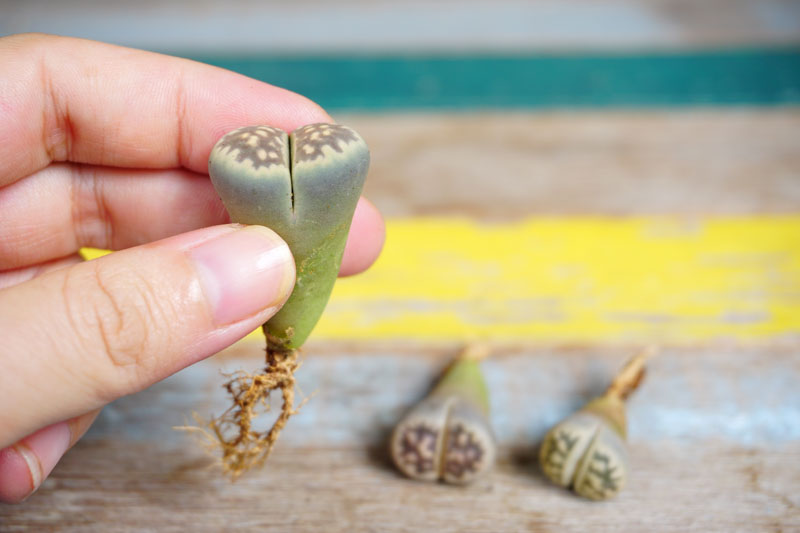
Propagating Lithops is a rewarding process that requires patience and care. These plants are typically propagated from seeds or by division, as each method suits different growth stages and goals.
Timing: The best time to sow Lithops seeds is in the spring or early summer, which mimics their natural germination period following seasonal rains in their native habitats.
Soil Preparation: Use a well-draining soil mix designed for cacti and succulents, or make your own by blending sand, perlite, and a small amount of compost.
Sowing: Spread the tiny seeds evenly over the surface of the soil. Do not cover them with soil, as they need light to germinate. Instead, gently press them into the soil to ensure contact.
Moisture: Keep the soil lightly moist but not waterlogged. A fine mist sprayer works well for this purpose. Covering the pot with plastic wrap or a glass pane can help retain moisture and warmth.
Light and Temperature: Place the pot in a bright area but out of direct sunlight. Warmth is essential for germination, so maintaining a temperature of around 65-75°F (18-24°C) is ideal.
Germination: Seeds typically germinate within two to twelve weeks. Once seedlings appear, gradually reduce humidity to acclimate them to drier conditions.
Timing: Division is best done when the plant is actively growing, usually in late spring or early summer.
Separating Clumps: Gently remove the Lithops from its pot and carefully separate the clump into individual plants, ensuring each division has roots attached.
Replanting: Plant each division in its own pot filled with a suitable well-draining soil mix. Water lightly to settle the soil around the roots.
Aftercare: Keep the newly potted divisions in a bright, warm location out of direct sunlight and water sparingly until you see new growth, indicating successful establishment.
Propagation success varies, and patience is key, especially when growing Lithops from seeds, as it can take several years for them to reach flowering size.
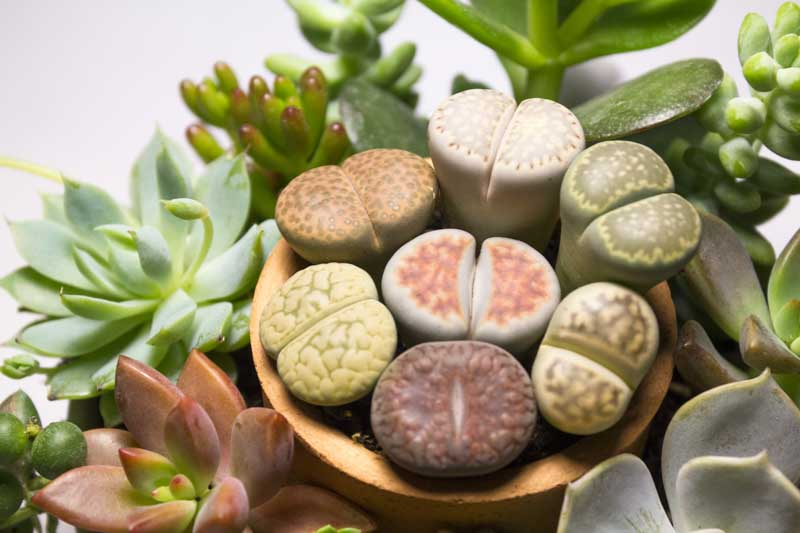
Lithops, with their unique and intriguing appearance, are generally resilient plants that don’t succumb easily to pests or diseases. However, like all plants, they can encounter a few problems, especially when not provided with ideal growing conditions.
Fungus gnats: Overwatering can lead to fungus gnat problems, as these pests are attracted to moist soil. Reducing watering and allowing the soil to dry out can help prevent them.
Mealybugs: These are the most common pests that might trouble Lithops, hiding in the crevices between the leaves. An infestation can be treated with a cotton swab dipped in alcohol to remove the pests, or by applying insecticidal soap or neem oil.
Root rot: This is the most significant threat to Lithops, usually a result of overwatering or poorly draining soil. Prevention is key; ensure the soil mix is well-draining and be cautious with watering schedules. Affected plants may need to be discarded if the damage is severe.
Mold and Mildew: Overly humid conditions or wet foliage can lead to fungal issues, such as powdery mildew. Ensuring good air circulation and avoiding water on the leaf surface can help prevent these problems.
Splitting or Cracking: If Lithops receive water at inappropriate times (such as during their dormant period in summer or when they are splitting to reveal new growth), their leaves can split or crack. Stick to a proper watering schedule, which usually means abstaining from watering during these critical periods.
Shriveling: Lithops may shrivel if they are under-watered, but this is their natural way to use up the old leaf pair during the growth of new leaves. Be careful not to confuse this process with dehydration.
Discoloration: Excessive sunlight can cause Lithops to bleach out and lose their color, whereas insufficient light can lead them to elongate unnaturally. Finding a balance in lighting is crucial.
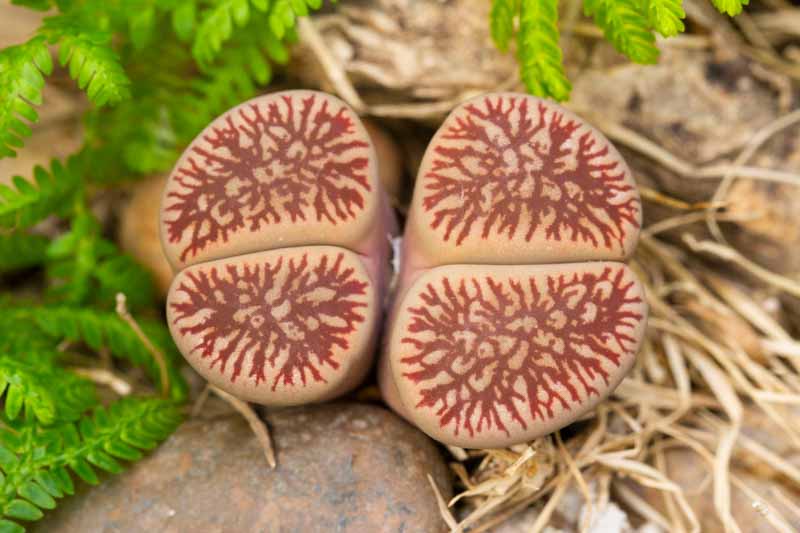
Lithops are not inherently difficult to keep alive, but they do have specific care requirements that differ from most other plants. Adhering to these requirements is key to their survival.
Watering is the most critical aspect of Lithops care. They require a “soak and dry” method; water thoroughly, allowing the soil to completely dry out before watering again. They have two main growth periods in spring and autumn when they need more water. During their summer and winter dormancy periods, watering should be very minimal or stopped altogether.
Yes, Lithops can multiply both by self-seeding and by forming new leaf pairs (bodies). Division occurs naturally when a single plant splits to form two or more pairs of leaves, gradually forming a clump.
With proper care, Lithops can live for 40-50 years. They are perennial plants that can survive for decades in their natural habitat and can do so in cultivation as well.
Lithops prefer a well-draining soil mix, typically composed of a cactus and succulent mix with added sand or pumice to improve drainage. They thrive in poor, rocky soils that mimic their natural environment.
Lithops, like other plants, photosynthesize to produce energy. Their translucent top surface allows light to penetrate to the photosynthetic tissues inside the leaf. This adaptation allows them to maximize light absorption while minimizing water loss in their arid native habitats.
| Hardiness |
10 - 11 |
|---|---|
| Plant Type | Houseplants, Cactus & Succulents |
| Plant Family | Aizoaceae |
| Exposure | Full Sun, Partial Sun |
| Season of Interest |
Spring (Early, Mid, Late) Summer (Early, Mid, Late) Fall Winter |
| Height |
1" - 2" (3cm - 5cm) |
| Spread |
1" - 2" (3cm - 5cm) |
| Spacing | 2" (5cm) |
| Maintenance | Low |
| Water Needs | Low |
| Soil Type | Loam, Sand |
| Soil pH | Acid, Neutral, Alkaline |
| Soil Drainage | Well-Drained |
| Characteristics | Showy, Evergreen |
| Tolerance | Drought |
| Garden Uses | Patio And Containers |
| Garden Styles | Gravel and Rock Garden |
| Hardiness |
10 - 11 |
|---|---|
| Plant Type | Houseplants, Cactus & Succulents |
| Plant Family | Aizoaceae |
| Exposure | Full Sun, Partial Sun |
| Season of Interest |
Spring (Early, Mid, Late) Summer (Early, Mid, Late) Fall Winter |
| Height |
1" - 2" (3cm - 5cm) |
| Spread |
1" - 2" (3cm - 5cm) |
| Spacing | 2" (5cm) |
| Maintenance | Low |
| Water Needs | Low |
| Soil Type | Loam, Sand |
| Soil pH | Acid, Neutral, Alkaline |
| Soil Drainage | Well-Drained |
| Characteristics | Showy, Evergreen |
| Tolerance | Drought |
| Garden Uses | Patio And Containers |
| Garden Styles | Gravel and Rock Garden |
How many Lithops (Living Stones) do I need for my garden?
| Plant | Quantity | |
|---|---|---|
| Lithops (Living Stones) | N/A | Buy Plants |
Create a membership account to save your garden designs and to view them on any device.
Becoming a contributing member of Gardenia is easy and can be done in just a few minutes. If you provide us with your name, email address and the payment of a modest $25 annual membership fee, you will become a full member, enabling you to design and save up to 25 of your garden design ideas.
Join now and start creating your dream garden!
Create a membership account to save your garden designs and to view them on any device.
Becoming a contributing member of Gardenia is easy and can be done in just a few minutes. If you provide us with your name, email address and the payment of a modest $25 annual membership fee, you will become a full member, enabling you to design and save up to 25 of your garden design ideas.
Join now and start creating your dream garden!